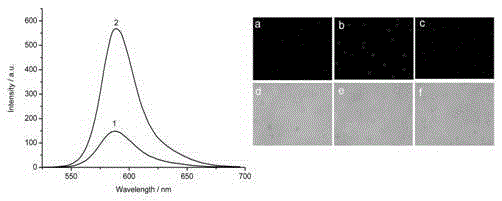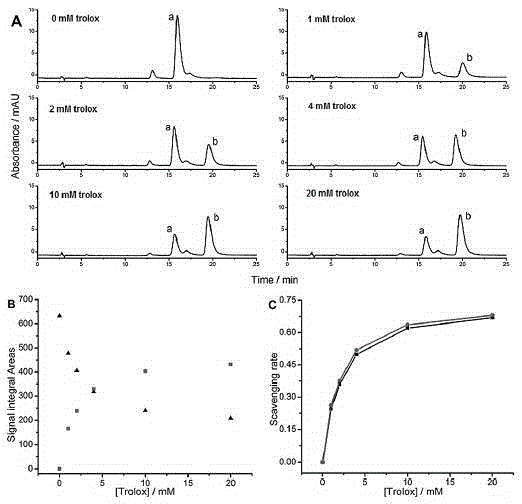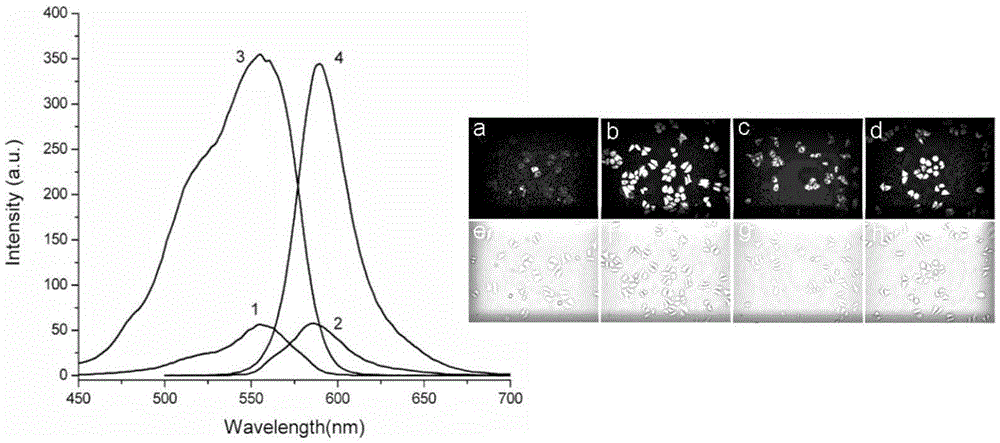Spin labeled fluorescent probe with single electron structure and application thereof
A technology of spin labeling and fluorescent probes, applied in fluorescence/phosphorescence, luminescent materials, organic chemistry, etc., can solve the problems of oxidative damage to the body, affect physiological functions, increase active oxygen, etc., and achieve low cytotoxicity and mild reaction conditions , good cell permeability
- Summary
- Abstract
- Description
- Claims
- Application Information
AI Technical Summary
Problems solved by technology
Method used
Image
Examples
Embodiment 1
[0039] Example 1: Synthesis of spin-labeled fluorescent probes
[0040] Proceed as follows:
[0041] (1) Rhodamine B (0.27mmol) and 4-hydroxyl-2,2,6,6,-tetramethyl-piperidine nitroxide radicals in equimolar amounts were added to the reaction solvent 10mL dichloromethane, and 4-Dimethylaminopyridine (0.027mmol) (as a catalyst), stirred for 20 minutes, then added N,N'-dicyclohexylcarbodiimide (0.27mmol) (as a dehydrating agent), and reacted at room temperature under the protection of argon 24h.
[0042] (2) The solvent was removed by rotary evaporation under reduced pressure, and the heating temperature was lower than 50°C.
[0043] (3) With dichloromethane / methanol=20 / 1 (v / v) as eluent, 200 mesh neutral alumina is as stationary phase, carry out column chromatographic separation; Spin labeled fluorescent probes.
Embodiment 2
[0044] Example 2: Detection experiment of intracellular hydroxyl radicals
[0045] The in vitro hydroxyl radical generation method adopts the classic Fenton system, that is, hydrogen peroxide is catalyzed by ferrous ion ([Fe 2+ ] / [H 2 o 2 ]=1:6), the hydroxyl group is captured by DMSO (1%) in acetonitrile to generate a relatively stable methyl radical, which combines with the probe to generate a stable product, which leads to the recovery of fluorescence to achieve the purpose of detection. In the hydroxyl radical detection reagent, the concentration of the probe is 7.5 μM, and the concentration of the hydroxyl radical is 0-100 μM. And the probe has good selectivity for hydroxyl radicals in the presence of DMSO. For the detection of hydroxyl free radicals produced by cells, rotenone was used to stimulate the cells, and a comparative study was carried out on liver cancer cells and normal cells. In the intracellular hydroxyl radical detection reagent, the cells were pretreat...
Embodiment 3
[0047] Example 3: Detection experiment of intracellular thiol free radicals
[0048] The in vitro glutathione free radical generation method uses horseradish peroxidase to oxidize phenol to generate phenoxy free radicals in the presence of hydrogen peroxide, and then oxidizes glutathione to generate glutathione free radicals, and then probes Capture glutathione free radicals to generate corresponding fluorescent derivatives. In vitro glutathione free radical detection reagent, probe 5 μM, with phenol 20 μM, glutathione 5 μM, hydrogen peroxide 5 μM and horseradish peroxidase 0.0625 U / mL in phosphate at 10 mM (pH 7.4) React in buffer solution for 10 min. For the detection of glutathione free radicals produced by cells, HL-60 cells rich in myeloperoxidase were selected. In the intracellular glutathione free radical detection reagent, the cells were pretreated with 2 μM probe for 10 min, and then mixed with 10 μM phenol After incubation with 2 μM hydrogen peroxide for 10 min, th...
PUM
 Login to View More
Login to View More Abstract
Description
Claims
Application Information
 Login to View More
Login to View More - R&D
- Intellectual Property
- Life Sciences
- Materials
- Tech Scout
- Unparalleled Data Quality
- Higher Quality Content
- 60% Fewer Hallucinations
Browse by: Latest US Patents, China's latest patents, Technical Efficacy Thesaurus, Application Domain, Technology Topic, Popular Technical Reports.
© 2025 PatSnap. All rights reserved.Legal|Privacy policy|Modern Slavery Act Transparency Statement|Sitemap|About US| Contact US: help@patsnap.com



